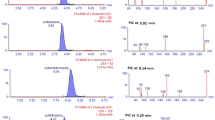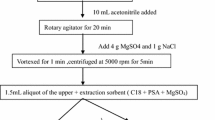Abstract
This manuscript describes a simple, reliable, and sensitive approach that utilizes high-performance liquid chromatography-electrospray ionization tandem triple quadrupole mass spectrometry (HPLC-ESI/MS/MS) for the selective determination of chloramphenicol, thiamphenicol, florfenicol, and florfenicol amine in poultry eggs (hen eggs, duck eggs, and goose eggs). Samples were extracted with methanol-ammonium hydroxide-ultrapure water (97:2:1, v/v) via accelerated solvent extraction (ASE) at 80 °C and 1500 psi and defatted with hexane saturated with acetonitrile. The experimental method uses ESI (+) and ESI (−) combination mode, full-scan qualitative analysis, and multiple reaction monitoring (MRM) combined with an internal standard for quantitative analysis. This optimized method was validated according to the requirements defined by the European Union and the Food and Drug Administration. The poultry eggs were spiked with the target compounds at four levels, and the average recoveries were all higher than 88.3%, and the relative standard deviations did not exceed 3.9%. The limits of detection and limits of quantification were 0.04–0.5 μg/kg and 0.1–1.5 μg/kg, respectively. The decision limits were 0.37–102 μg/kg, and the detection capabilities were 0.44–103 μg/kg. Finally, the new approach was successfully applied to the quantitative determination of these analytes in 120 commercial poultry eggs from local supermarkets.


Similar content being viewed by others
References
Alechaga E, Moyano E, Galceran MT (2012) Ultra-high performance liquid chromatography-tandem mass spectrometry for the analysis of phenicol drugs and florfenicol-amine in foods. Analyst 137:2486–2494. https://doi.org/10.1039/c2an16052h
An L, Wang Y, Pan Y, Tao Y, Chen D, Liu Z, Yang W, Peng D, Yuan Z (2016) Development and validation of a sensitive indirect competitive enzyme-linked immunosorbent assay for the screening of florfenicol and thiamphenicol in edible animal tissue and feed. Food Anal Methods 9:1–10. https://doi.org/10.1007/s12161-016-0436-3
Barreto F, Ribeiro C, Hoff RB, Costa TD (2016) Determination of chloramphenicol, thiamphenicol, florfenicol and florfenicol amine in poultry, swine, bovine and fish by liquid chromatography-tandem mass spectrometry. J Chromatogr A 1449:48–53. https://doi.org/10.1016/j.chroma.2016.04.024
Du X, Xia C, Shen J, Wu B, Shen Z (2004) Characterization of florfenicol resistance among calf pathogenic Escherichia coli. FEMS Microbiol Lett 236:183–189. https://doi.org/10.1016/j.femsle.2004.05.013
Faulkner D, Cantley M, Walker M, Crooks S, Kennedy D, Elliott C (2016) Evidence of non-extractable florfenicol residues: development and validation of a confirmatory method for total florfenicol content in kidney by UPLC-MS/MS. Food Addit Contam Part A Chem Anal Control Expo Risk Assess 33:983–994. https://doi.org/10.1080/19440049.2016.1175187
Fedeniuk RW, Mizuno M, Neiser C, O’Byrne C (2015) Development of LC-MS/MS methodology for the detection/determination and confirmation of chloramphenicol, chloramphenicol 3-O-beta-d-glucuronide, florfenicol, florfenicol amine and thiamphenicol residues in bovine, equine and porcine liver. J Chromatogr B 991:68–78. https://doi.org/10.1016/j.jchromb.2015.04.009
Festing MF, Diamanti P, Turton JA (2001) Strain differences in haematological response to chloramphenicol succinate in mice: implications for toxicological research. Food Chem Toxicol 39:375–383. https://doi.org/10.1016/S0278-6915(00)00149-6
Graziani C, Busani L, Dionisi AM, Lucarelli C, Owczarek S, Ricci A, Mancin M, Caprioli A, Luzzi I (2008) Antimicrobial resistance in Salmonella enterica serovar Typhimurium from human and animal sources in Italy. Vet Microbiol 128:414–418. https://doi.org/10.1016/j.vetmic.2007.10.017
Hanekamp JC, Bast A (2015) Antibiotics exposure and health risks: chloramphenicol. Environ Toxicol Pharmacol 39:213–220. https://doi.org/10.1016/j.etap.2014.11.016
Holt DE, Andrews CM, Payne JP, Williams TC, Turton JA (1998) The myelotoxicity of chloramphenicol: in vitro and in vivo studies: II: in vivo myelotoxicity in the B6C3F1 mouse. Hum Exp Toxicol 17:8–17. https://doi.org/10.1177/096032719801700102
Liu HY, Lin SL, Fuh MR (2016) Determination of chloramphenicol, thiamphenicol and florfenicol in milk and honey using modified QuEChERS extraction coupled with polymeric monolith-based capillary liquid chromatography tandem mass spectrometry. Talanta 150:233–239. https://doi.org/10.1016/j.talanta.2015.12.045
Luo P, Chen X, Liang C, Kuang H, Lu L, Jiang Z, Wang Z, Li C, Zhang S, Shen J (2010) Simultaneous determination of thiamphenicol, florfenicol and florfenicol amine in swine muscle by liquid chromatography-tandem mass spectrometry with immunoaffinity chromatography clean-up. J Chromatogr B 878:207–212. https://doi.org/10.1016/j.jchromb.2009.10.002
Ministry of Agriculture of the People’s Republic of China (2002) Maxium residue level of veterinary drugs in food of animal origin. Notice no. 235 (appendix 4). Ministry of Agriculture, Beijing
Orlando EA, Roque AGC, Losekann ME, Simionato AVC (2016) UPLC-MS/MS determination of florfenicol and florfenicol amine antimicrobial residues in tilapia muscle. J Chromatogr B 1035:8–15. https://doi.org/10.1016/j.jchromb.2016.09.013
Pan X-D, Wu P-G, Jiang W, Ma B-J (2015) Determination of chloramphenicol, thiamphenicol, and florfenicol in fish muscle by matrix solid-phase dispersion extraction (MSPD) and ultra-high pressure liquid chromatography tandem mass spectrometry. Food Control 52:34–38. https://doi.org/10.1016/j.foodcont.2014.12.019
Shen J, Xia X, Jiang H, Li C, Li J, Li X, Ding S (2009) Determination of chloramphenicol, thiamphenicol, florfenicol, and florfenicol amine in poultry and porcine muscle and liver by gas chromatography-negative chemical ionization mass spectrometry. J Chromatogr B 877:1523–1529. https://doi.org/10.1016/j.jchromb.2009.03.040
Sichilongo KF, Kolanyane P, Masesane IB (2014) A sensitive LC-MS/MS method employing a THF–water solvent system for the determination of chloramphenicol, thiamphenicol and florfenicol in bovine muscle. Anal Methods 6:7015–7021. https://doi.org/10.1039/C4AY01135J
Tao Y, Zhu F, Chen D, Wei H, Pan Y, Wang X, Liu Z, Huang L, Wang Y, Yuan Z (2014) Evaluation of matrix solid-phase dispersion (MSPD) extraction for multi-fenicols determination in shrimp and fish by liquid chromatography-electrospray ionisation tandem mass spectrometry. Food Chem 150:500–506. https://doi.org/10.1016/j.foodchem.2013.11.013
The European Communities (2002) Commission decision 2002/657/EC of 12 august 2002 implementing council directive 96/23/EC concerning the performance of analytical methods and the interpretation of results. Off J Eur Commun 221:8–36
The European Medicines Agency (2010) Commission regulation (EU) No. 37/2010 of 22 December 2009 on pharmacologically active substances and their classification regarding maximum residue limits in foodstuffs of animal origin. The European Medicines Agency, Canary Wharf
US Department of Health and Human Services, Food and Drug Administration, Center for Drug Evaluation and Research, Center for Veterinary Medicine (2001) Guidance for industry: bioanalytical method validation. US Department of Health and Human Services, Washington, DC
US Food and Drug Administration (2014) CFR-code of federal regulations title 21 part 556 tolerances for residues of new animal drugs in food. US Food and Drug Administration. Silver Spring, Maryland
Xiao Z, Song R, Rao Z, Wei S, Jia Z, Suo D, Fan X (2015) Development of a subcritical water extraction approach for trace analysis of chloramphenicol, thiamphenicol, florfenicol, and florfenicol amine in poultry tissues. J Chromatogr A 1418:29–35. https://doi.org/10.1016/j.chroma.2015.09.047
Xie K, Jia L, Yao Y, Xu D, Chen S, Xie X, Pei Y, Bao W, Dai G, Wang J, Liu Z (2011) Simultaneous determination of thiamphenicol, florfenicol and florfenicol amine in eggs by reversed-phase high-performance liquid chromatography with fluorescence detection. J Chromatogr B 879:2351–2354. https://doi.org/10.1016/j.jchromb.2011.06.027
Xie X, Wang B, Pang M, Zhao X, Xie K, Zhang Y, Wang Y, Guo Y, Liu C, Bu X, Wang R, Shi H, Zhang G et al (2018) Quantitative analysis of chloramphenicol, thiamphenicol, florfenicol and florfenicol amine in eggs via liquid chromatography-electrospray ionization tandem mass spectrometry. Food Chem 269:542–548. https://doi.org/10.1016/j.foodchem.2018.07.045
Zhang S, Liu Z, Guo X, Cheng L, Wang Z, Shen J (2008) Simultaneous determination and confirmation of chloramphenicol, thiamphenicol, florfenicol and florfenicol amine in chicken muscle by liquid chromatography-tandem mass spectrometry. J Chromatogr B 875:399–404. https://doi.org/10.1016/j.jchromb.2008.09.035
Funding
This research was financially supported by the China Agriculture Research System (CARS-41-G23), the Priority Academic Programme Development of Jiangsu Higher Education Institutions (PAPD), the Project of Drafting and Revision of the National Agriculture Industry Standard for Quality and Safety of Agricultural Products (181721301092371104), the Project of Jiangsu Agricultural Science and Technology Independent Innovation Fund (CX (18) 3022), the Yangzhou University High-end Talent Support Programme and the Yangzhou University International Academic Exchange Foundation.
Author information
Authors and Affiliations
Corresponding author
Ethics declarations
Conflict of Interest
Bo Wang declares that he has no conflict of interest. Xia Zhao declares that he has no conflict of interest. Xing Xie declares that he has no conflict of interest. Kaizhou Xie declares that he has no conflict of interest. Genxi Zhang declares that he has no conflict of interest. Tao Zhang declares that he has no conflict of interest. Xuezhong Liu declares that he has no conflict of interest.
Ethical Approval
This article does not present any studies with human participants or animals performed by any of the authors.
Informed Consent
Not applicable.
Additional information
Publisher’s Note
Springer Nature remains neutral with regard to jurisdictional claims in published maps and institutional affiliations.
Rights and permissions
About this article
Cite this article
Wang, B., Zhao, X., Xie, X. et al. Development of an Accelerated Solvent Extraction Approach for Quantitative Analysis of Chloramphenicol, Thiamphenicol, Florfenicol, and Florfenicol Amine in Poultry Eggs. Food Anal. Methods 12, 1705–1714 (2019). https://doi.org/10.1007/s12161-019-01517-4
Received:
Accepted:
Published:
Issue Date:
DOI: https://doi.org/10.1007/s12161-019-01517-4




